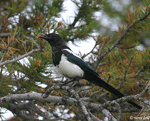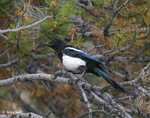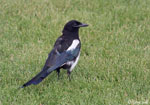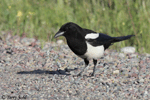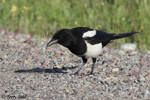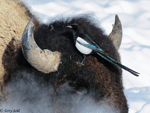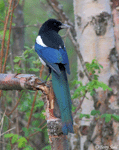| Length: 18 to 21 inches | Wingspan: 24 inches | Seasonality: All Seasons |
| ID Keys: Distinctive, black overall with white belly, sides, and wing patch, extremely long tail. | ||
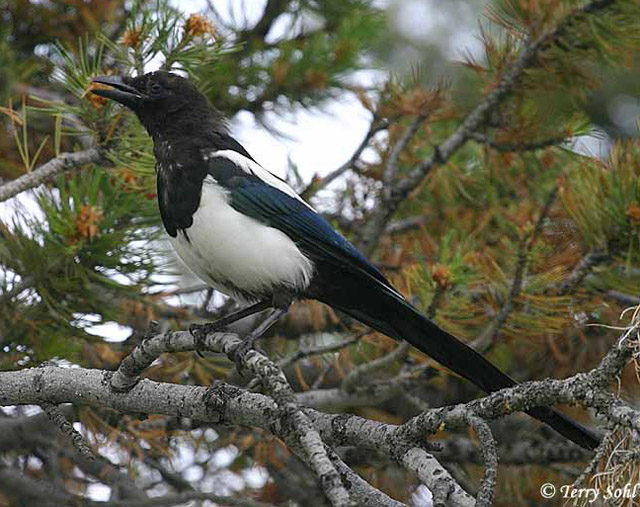 A boldly patterned bird of
the western U.S., Black-billed Magpies are conspicuous both in appearance, and
in nesting behavior. With a bold black-and-white plumage pattern and an
extremely long tail, they are unmistakable bird in flight in much of western
North America. As nesting birds, they build massive domed nests that may be more than three feet wide
in diameter. Black-billed Magpies were once commonly kept as cage
birds. They were often the direct targets of farmers and ranchers trying
to eliminate them, and were indirectly affected by poison baits set out for
predators. However, they are now once again common and widespread in much
of western North America.
A boldly patterned bird of
the western U.S., Black-billed Magpies are conspicuous both in appearance, and
in nesting behavior. With a bold black-and-white plumage pattern and an
extremely long tail, they are unmistakable bird in flight in much of western
North America. As nesting birds, they build massive domed nests that may be more than three feet wide
in diameter. Black-billed Magpies were once commonly kept as cage
birds. They were often the direct targets of farmers and ranchers trying
to eliminate them, and were indirectly affected by poison baits set out for
predators. However, they are now once again common and widespread in much
of western North America.
Habitat:
Prefers mixed habitat, avoids unbroken forest or treeless prairie. Includes rangeland (with trees), farms and farmland, riparian areas, shelterbelts, and residential areas.
Diet:
Omnivorous, feeding on insects, rodents, eggs and bird young, reptiles, snakes, carrion, seeds, nuts, fruits and berries, depending upon the location and season.
Behavior:
Primarily forages by walking along the ground. Often bold in flight and while perched, they're a hard bird not to notice most of the time. They will often perch in prominent locations, and when taking flight, the bold color plumage pattern and extremely long tail make the bird instantly recognizable. They are one of a few bird species thought to be able to detect food by smell, a characteristic that may allow them to easily find carrion.
Nesting:
May through July. The nest of a Black-billed Magpie is large dome with a side entrance, built of sticks and twigs, and up to 3 feet in diameter. The female lays betwen 5 and 9 eggs, and she alone incubates them, while the male brings food to her. After the eggs hatch, both parents help tend to the young and bring food to them. The young leave the nest after about 4 weeks.
Interactive eBird Map:
Click to access an interactive eBird map of Black-billed Magpie sightings
Song and Calls:
Noisy, with a variety of vocalizations:
- 1Click here to hear the noisy chattering of a Black-billed Magpie, recorded in Washington state.
- 2Click here to hear alarm calls of a Black-billed Magpie, recorded in Apache County, Arizona.
- 3Click here to hear more vocalizations of a Black-billed Magpie, recorded in Salt Lake County, Utah.
Migration:
Permanent resident throughout its range. Typical range maps and supporting data tend to show the eastern half of South Dakota as an area where Black-billed Magpies may occasionally visit during the winter months. Note in 20+ years of birding eastern South Dakota extensively, I've only seen one pair of Black-billed Magpies, near Yankton on the South Dakota/Nebraska border.
Similar Species:
In South Dakota, you're unlikely to mistake the Black-billed Magpie with any other species. The large size and structure of the bird may initially lead to confusion with corvids (American Crow, Common Raven) if seen from a distance, but the bold black-and-white plumage pattern and that impossibly long tail make it readily identifiable if seen well. Outside of South Dakota, Black-billed Magpie may be confused with the following:
- Yellow-billed Magpie - Nearly identical in overall appearance, the trademark yellow-bill of a Yellow-billed Magpie is the easy way to differentiate the two species. Note Yellow-billed Magpie has an extremely restricted range as well, only being found in and around the Central Valley of California.
Conservation Status:
Although thousands were once killed by poison baits set out for predators, Black-billed Magpie populations rebounded. They are now considered stable, are found across a broad geographic area, and are common in parts of their range. The IUCN lists the Black-billed Magpie as a species of "Least Concern".
Further Information:
- USGS Patuxent Bird Identification InfoCenter, Black-billed Magpie
- WhatBird - Black-billed Magpie
- Audubon Guide - Black-billed Magpie
Photo Information:
August 25th, 2004 -- Near Mammoth Hot Springs in Yellowstone National Park -- Terry Sohl
Additional Photos:
Click on the image chips or text links below for additional, higher-resolution Black-billed Magpie photos.
Audio File Credits:
- 1Bruce Lagerquist, XC437510. Accessible at www.xeno-canto.org/437510.
- 2Eric Hough, XC291049. Accessible at www.xeno-canto.org/291049
- 3Michael Lester, XC300056. Accessible at www.xeno-canto.org/300056.
| Click on the map below for a higher-resolution view |
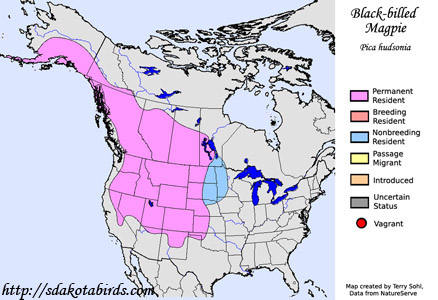 |
| South Dakota Status: Uncommon resident in the western half of the state, and areas near the Missouri River. Occasional winter visitor in the rest of the state. |
Additional Black-billed Magpie Photos
Click for a higher-resolution version of these photos
